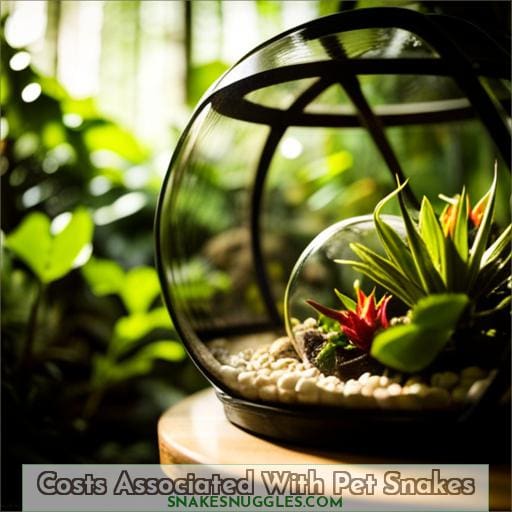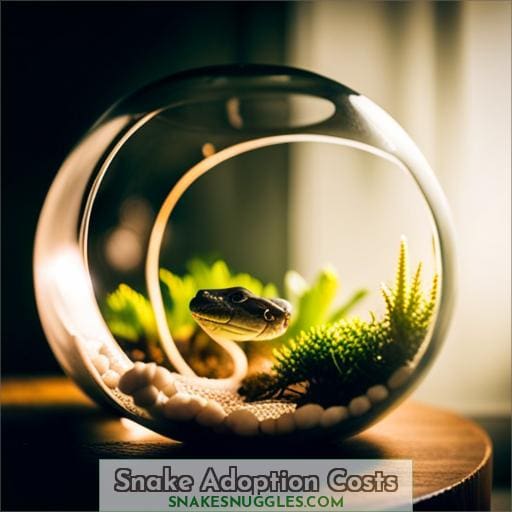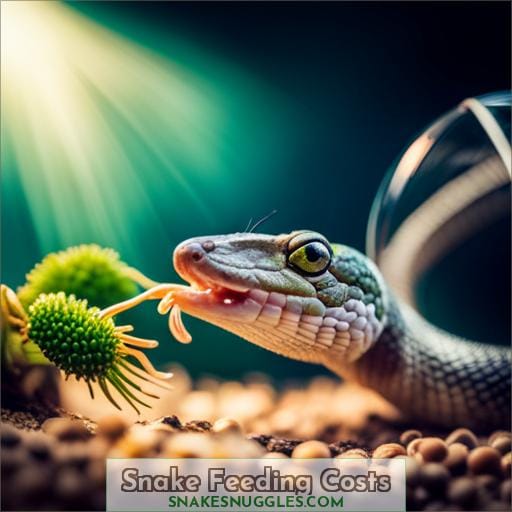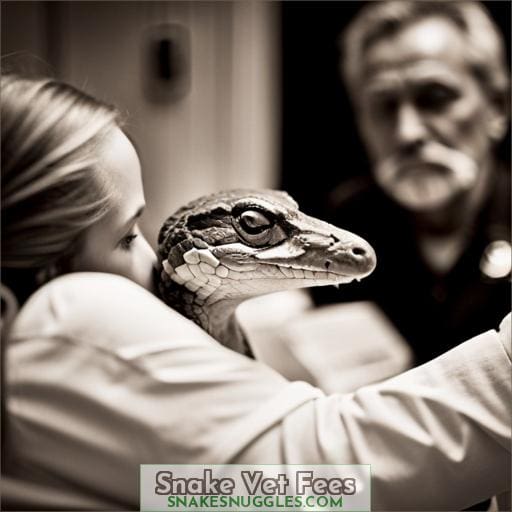This site is supported by our readers. We may earn a commission, at no cost to you, if you purchase through links.

The truth is, snakes are the ultimate low-maintenance pets, costing less than dogs, cats, or even rodents.
This article will break down the pet snake cost, from the initial purchase to the ongoing expenses of food, supplies, and vet care.
Whether you’re a seasoned snake enthusiast or just curious about these fascinating creatures, read on to discover how much it costs to own a pet snake.
Table Of Contents
- Key Takeaways
- Cost of Buying a Snake
- Costs Associated With Pet Snakes
- Enclosure & Setup Maintenance
- Vet Care
- Money-Saving Tips for Snake Keepers
- Snake Adoption Costs
- Snake Care Costs
- Snake Feeding Costs
- Snake Vet Fees
- Frequently Asked Questions (FAQs)
- What are the differences between the Brooks King Snake, Corn Snake, and Kenyan Sand Boa in terms of their size, temperament, and dietary needs?
- Are there any unique or rare snake species available for purchase, and if so, what are their typical price ranges?
- What are the specific requirements for maintaining proper temperature and humidity levels within a snake’s enclosure, and how can these conditions be monitored effectively?
- Are there any specific snake breeds that are considered to be more suitable for beginners, and if so, why are these breeds considered to be ideal for novice snake owners?
- What are the potential risks associated with owning a pet snake, and what precautions can be taken to ensure the safety and well-being of both the snake and its owner?
- Conclusion
Key Takeaways
- Pet snake prices range from $20 to $1,000, affected by species and location.
- Snake care costs include feeding, heating, substrate, enclosure setup, and maintenance.
- Snake lifespan costs vary depending on the species, vet fees, and habitat expansion.
- Routine checkups, preventive care, and insurance options are important for a snake’s well-being.
Cost of Buying a Snake
You’ll pay anywhere from $20 to $1,000 to buy a snake, depending on the species and where you purchase it.
Snake breeders, adoption processes, and online purchases all influence the cost.
Garter snakes, for instance, typically range from $20 to $300, while corn snakes can set you back $40 to $1,000.
For those seeking a hognose snake, expect to pay between $100 and $700, whereas sunbeam snakes generally cost between $50 and $125.
Rare species and unique morphs can significantly inflate prices, reaching up to $5,000 or more.
Researching market variations and exploring adoption options can help you find a snake that fits your budget and lifestyle.
Costs Associated With Pet Snakes
As you consider getting a pet snake, you’ll need to budget for:
- Feeding costs
- A heating source
- A thermometer
You’ll need to feed your snake small rodents, such as mice or rats.
You’ll need to keep the snake’s enclosure at a warm temperature.
A thermometer will help you monitor the temperature of the enclosure.
Feeding
Depending on your snake’s species and age, you’ll need to feed it a diet consisting of small rodents.
Research your snake’s specific dietary needs and establish a feeding schedule that accommodates its growth and activity level.
Explore diverse food source options, including frozen or live rodents, to ensure your snake receives a balanced diet.
Consider nutritional supplements if necessary.
Maintain a clean and hygienic feeding environment to prevent health issues.
Heating Source
For your snake’s optimal health and comfort, you’ll need to purchase one or two heating sources.
Consider heating pads, cables, and lamps to maintain proper temperatures.
Ensure heating efficiency by selecting products with adjustable thermostats for precise temperature regulation.
Explore alternative sources like ceramic heat emitters, which offer energy consumption and don’t emit light, making them suitable for nighttime use.
Choose reliable brands and models with accurate thermostats to prevent overheating or underheating.
Thermometer
Next, you’ll want to budget for a thermometer to accurately gauge the surface and ambient air temperatures in your snake’s enclosure. This is crucial for maintaining optimal temperature gradients and ensuring your snake’s comfort and well-being.
Digital Thermometers: These provide precise readings and are easy to use.
Infrared Thermometers: Measure surface temperatures without contact, allowing for non-invasive monitoring.
Humidity Gauges: Particularly important for species requiring specific humidity levels.
Substrate
Stock up on substrate, whether it’s newspapers, mulch, or bark, to absorb your snake’s waste.
Select substrates that mimic your snake’s natural habitat, ensuring its comfort and well-being.
Consider the substrate’s absorbency, ease of cleaning, and impact on humidity levels.
DIY options like shredded paper or coconut husk can be cost-effective and eco-friendly.
Regular maintenance involves spot-cleaning and complete substrate changes to maintain hygiene and prevent health issues.
Enclosure & Setup Maintenance
The type of enclosure you choose for your snake will depend on its size and species.
Features like cable gateways, built-in lighting, and detachable partitions can make maintenance easier.
Bigger enclosures are more expensive, so consider your snake’s needs carefully.
Type of Enclosure
Moving on to housing, you’ll need to choose between aquariums, plastic storage containers, or industrial reptile cages for your snake’s enclosure.
Aquariums offer clear visibility.
Plastic containers are cost-effective.
Industrial cages provide ample space and customization options.
Consider factors like snake size, species-specific needs, and your budget when making your choice.
Features
In selecting an enclosure for your snake, consider features like cable gateways, built-in lighting, and detachable partitions.
These features cater to their needs and facilitate easy maintenance.
Proper ventilation, temperature regulation, and ease of cleaning are ensured, promoting your snake’s well-being.
Moreover, built-in lighting systems mimic natural day-night cycles, aiding in regulating their circadian rhythm and overall health.
Size of Enclosure
You’ll want to buy an enclosure that’s big enough for your snake to move around comfortably.
Different snake species need varying space requirements.
A good rule of thumb is to provide at least 10 gallons of space per foot of snake length.
This ensures adequate space for movement, thermoregulation, and hiding.
Consider the snake’s housing needs over its lifetime, as some species can grow quite large.
Vet Care
Vet appointments can put a dent in your budget, so be prepared for checkups, testing, and treatments. Just like any pet, snakes can fall ill or encounter emergencies, leading to unforeseen expenses.
Unexpected illnesses and accidents can lead to hefty vet bills.
Preventive care, like routine checkups, can catch health issues early, potentially saving you money in the long run.
Consider insurance options to help offset the cost of unexpected medical expenses.
Don’t hesitate to seek specialist referrals if your snake requires specialized care.
Emergency expenses can be substantial, so having a financial cushion is crucial.
Money-Saving Tips for Snake Keepers
Now that you’re aware of the potential costs associated with snake ownership, let’s delve into some practical, money-saving tips that can help you keep your passion for these fascinating creatures without breaking the bank.
DIY Enrichment:
- Instead of purchasing expensive toys, create your own enrichment items using household objects like cardboard boxes, paper towel rolls, and branches.
- This not only saves money but also engages your snake’s natural instincts and keeps them entertained.
Reusable Substrate:
- Opt for reusable substrates like newspaper, paper pellets, or coconut husk instead of disposable ones.
- These options aren’t only cost-effective but also eco-friendly, reducing waste and contributing to a more sustainable pet-keeping practice.
Seasonal Feeding:
- Adjust your snake’s feeding schedule according to the seasons.
- During cooler months, snakes naturally eat less, so you can reduce the frequency of feedings while still ensuring they receive adequate nutrition.
- This simple adjustment can lead to significant savings on food costs over time.
By implementing these tips, you can significantly reduce the financial burden of snake ownership while providing your scaly companion with a stimulating and healthy environment.
Snake Adoption Costs
The average cost of adopting a snake ranges from $50 to $350, depending on the species, age, and location.
You’ll find various snake species yearning for a loving home at shelters and rescues, offering a second chance to these abandoned or surrendered scaly companions.
Adopting a snake not only saves a life but also supports the incredible work of animal shelters and rescue organizations.
Their tireless efforts ensure these adopted reptiles receive proper care, medical attention, and a safe haven until they find their forever home with you.
Embracing adoption not only fulfills your desire for a snake companion but also contributes to the well-being of these remarkable creatures and the organizations dedicated to their welfare.
Snake Care Costs
Besides the adoption fee, you’ll also need to budget for the costs of setting up and maintaining your snake’s habitat.
Setting up a snake’s enclosure can cost between $300 and $500. The size of the enclosure will depend on the size of your snake, but a good rule of thumb is to provide at least 10 gallons of space per foot of snake.
You’ll also need to purchase a substrate, such as newspaper, mulch, or bark, which should be changed every 2-3 months.
Lifespan Costs: Be prepared to cover costs associated with your snake’s lifespan, which can range from a few years to several decades, depending on the species.
Health Emergencies: You’ll need to budget for unexpected health emergencies, such as respiratory infections or parasites, which can require vet visits and medication.
Habitat Expansion: As your snake grows, you may need to upgrade to a larger enclosure to accommodate its size and provide adequate space for movement and enrichment.
Seasonal Adjustments: Depending on the climate and your snake’s species, you may need to adjust the temperature and humidity levels in its enclosure, which can require additional heating or cooling equipment.
Snake Feeding Costs
Factor in the cost of feeding your snake, which can range from $100 to $200 annually.
This cost is influenced by several factors, including the snake’s size, age, and species.
Generally, younger snakes eat more frequently than adults, and larger snakes require larger prey items.
Additionally, some snake species have specialized diets that may require more expensive or exotic food items.
To ensure your snake’s health and well-being, provide a varied diet that includes rodents, insects, and occasionally, eggs or chicks.
Snake Vet Fees
Don’t neglect your snake’s health. Factor in vet fees for checkups and potential treatments.
Routine checkups ensure your snake’s well-being. Catching issues early on can save you money and distress in the long run.
Preventive care like vaccinations, deworming, and regular checkups are essential for your snake’s health.
Insurance options provide peace of mind, covering unexpected medical costs. Policies vary.
Emergency funds are crucial for unexpected illnesses or injuries. Set aside funds specifically for vet care to avoid financial stress during emergencies.
Snake vet fees can be substantial. Consult a veterinarian to understand the potential costs associated with your snake’s breed.
Specialist visits may be necessary for specific health issues, increasing expenses.
Consider these factors when budgeting for your snake’s healthcare.
Frequently Asked Questions (FAQs)
What are the differences between the Brooks King Snake, Corn Snake, and Kenyan Sand Boa in terms of their size, temperament, and dietary needs?
The Brooks King Snake, Corn Snake, and Kenyan Sand Boa vary in size, temperament, and dietary needs.
The Brooks King Snake is relatively small, docile, and has a varied diet.
The Corn Snake is medium-sized, calm, and primarily eats rodents.
The Kenyan Sand Boa is large, docile, and has a specialized diet of small mammals and birds.
Are there any unique or rare snake species available for purchase, and if so, what are their typical price ranges?
Unlock the world of unique snake species, with prices reaching up to a staggering £5,000 for special morphs of ball pythons.
Explore the captivating beauty of these rare snakes.
Delve into their captivating behaviors.
What are the specific requirements for maintaining proper temperature and humidity levels within a snake’s enclosure, and how can these conditions be monitored effectively?
To ensure optimal well-being, maintaining proper temperature and humidity within your snake’s enclosure is crucial.
Utilize thermometers and hygrometers to monitor conditions and adjust heating and misting systems accordingly.
Creating a microclimate that replicates the snake’s natural habitat is essential.
Are there any specific snake breeds that are considered to be more suitable for beginners, and if so, why are these breeds considered to be ideal for novice snake owners?
Corn snakes and ball pythons are popular beginner snakes.
They are docile in nature, manageable in size, and adaptable to captivity.
Their hardiness and availability make them ideal for novice snake owners seeking a low-maintenance pet.
What are the potential risks associated with owning a pet snake, and what precautions can be taken to ensure the safety and well-being of both the snake and its owner?
Owning a pet snake carries potential risks:
- Bites
- Escapes
- Salmonella transmission
Ensure safety by:
- Handling snakes gently
- Securing enclosures
- Practicing proper hygiene
Regular vet checkups and responsible ownership are crucial for the well-being of both the snake and its owner.
Conclusion
Like a snake shedding its skin, you too must shed your preconceived notions of pet ownership to embrace the unique and rewarding experience of owning a pet snake.
The initial pet snake cost may seem daunting, but the ongoing expenses are surprisingly affordable, making snakes an excellent choice for budget-conscious individuals.
With proper care and maintenance, your scaly friend can thrive in your home, offering years of companionship and fascination.















